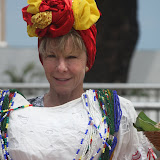
In early October, Granny, Donna & David met at the Charlotte airport and headed for Rio! Granny was anxious to see granddaughter Nicole and Ava, her great granddaughter for her second birthday party. Here we are on Copacabana.
Donna and I took some detours to Fortaleza to visit our friend Cira and enjoy some beach time then Salvador, where we chilled by the pool in a beautiful inn (see picture)located in the heart of the old part of Brazil’s most historic city.

Fortaleza, located in the country’s north east region is best known for its beaches. To us it is a smaller, more civilized Rio, without the crowds and yet with great food and lots to do at night. Our hotel was located right across from a great swimming beach and just up from the fisherman’s beach. In the evening a handicraft market was set up on the sidewalk and the restaurants were humming. Here is a picture taken from the hotel room window:

Cira was a great hostess, meeting us at the airport and whisking us off with daughter Celina to the “Sirigado” restaurant for a delicious (and huge) seafood lunch. Then it was off to shopping …. The one lucky piece of good news was that all Banks were on strike so we were unable to get any money to buy "stuff" - Seriously, the bank strike was a major inconvenience since ATM machines were emptied out in no time and cash was king. Dinner was at “Coco de Bambu” a charming outdoor restaurant where a few “caipinhas” were consumed to help with digestion.
The next day, Donna and I took off for a more remote beach “Canoa Quebrada” where we put our lives in the hands of a suicidal dune buggy driver who took us over 90 degree drops at great speed. Pictures of that day are here (double click on picture for album):
 |
| 2010-10-15 Fortaleza |
On the third day we walked up the fisherman’s beach and took these photos:
 |
| Fortaleza.boats |
We arrived in Salvador and were taken straight to our small Inn (12 rooms) in the center of “Pelourinho”, a UNESCO heritage site in the heart of the old city. Salvador was the first Capital of Brazil (under the Portuguese) and it grew rich on sugar. An integral part of its culture comes from the religions and traditions brought by the 1.3 million slaves (double the number that the US imported) that were imported to work the sugar cane. The following album contains photos around Pelourinho :
 |
| Salvador |
On return to Rio, we joined Granny again and enjoyed Ava's second birthday party.
 |
| Granny&Ava |
No comments:
Post a Comment